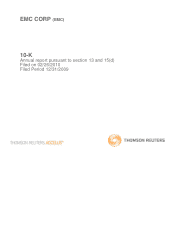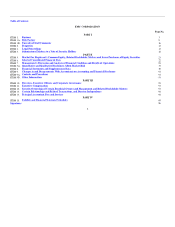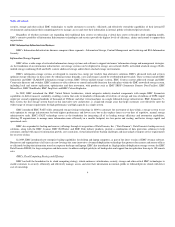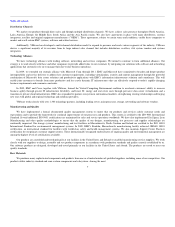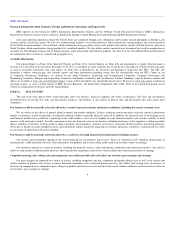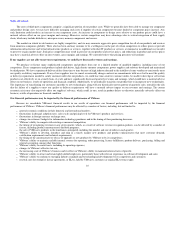EMC 2009 Annual Report Download - page 5
Download and view the complete annual report
Please find page 5 of the 2009 EMC annual report below. You can navigate through the pages in the report by either clicking on the pages listed below, or by using the keyword search tool below to find specific information within the annual report.
Table of Contents
security, storage and other critical EMC technologies to enable customers to securely, efficiently and effectively extend the capabilities of their internal IT
environments and maximize their computing power to manage, access and store their information in internal, public or federated private clouds.
Regardless of whether customers are expanding their traditional data centers or embracing a virtual data center or broader cloud computing models,
EMC's extensive portfolio of Information Infrastructure technologies and services provide the highest levels of efficiency, choice and control to support their
organization.
EMC Information Infrastructure Business
EMC's Information Infrastructure business comprises three segments – Information Storage, Content Management and Archiving and RSA Information
Security.
Information Storage Segment
EMC offers a wide range of networked information storage systems and software to support customers' information storage and management strategies.
As the foundation of an information infrastructure, our storage systems can be deployed in storage area network (SAN), networked attached storage (NAS),
unified storage combining NAS and SAN, content addressed storage and/or direct attached storage environments.
EMC's information storage systems are designed to consume less energy per terabyte than alternative solutions. EMC's advanced tools and services
optimize energy efficiency in data centers by reducing energy demands, costs and outages caused by overburdened power grids. These systems include EMC
Symmetrix and EMC CLARiiON information storage systems, EMC Celerra unified storage systems, EMC Centera content addressed storage and EMC
Connectrix directors and switches. EMC continues to offer software to control and enable functions that take place within the EMC networked storage system,
including local and remote replication, optimization and data movement, with products such as EMC SRDF (Symmetrix Remote Data Facility), EMC
MirrorView, EMC TimeFinder, EMC SnapView and EMC Celerra Replicator.
In 2009, EMC introduced the EMC Virtual Matrix Architecture, which integrates industry-standard components with unique EMC Symmetrix
capabilities to deliver massive scalability, enabling systems that scale to hundreds of thousands of terabytes of storage and tens of millions of IOPS (input/
output per second) supporting hundreds of thousands of VMware and other virtual machines in a single federated storage infrastructure. EMC Symmetrix V-
Max system, the first storage system based on this innovative new architecture, is a high-end storage array that helps customers cost-effectively meet the
widest range of storage requirements for high performance and high capacity in a single system.
EMC introduced EMC FAST (fully automated storage tiering) technology in 2009 to automate the movement of data within a storage system to not
only optimize its storage infrastructure for both highest performance and lowest cost, but to also replace hours or even days of repetitive, manual storage
administrative tasks. EMC's FAST technology serves as the foundation for integrating all of its leading storage efficiency and automation capabilities,
allowing IT organizations to manage more information more efficiently in a smaller footprint, use less power and cooling, and lower storage capital and
operational costs.
EMC also expanded its backup and recovery offerings through its acquisition of Data Domain, Inc. ("Data Domain"). Data Domain's backup recovery
solutions, along with the EMC Avamar, EMC NetWorker and EMC Disk Library products, provide a combination of data protection solutions to help
customers contend with massive information growth, cost constraints, virtual infrastructure backup challenges and increasingly stringent service requirements
for recovery of data.
In 2009, EMC introduced new enterprise backup capabilities for desktop and laptop computers, as part of the latest version of EMC Avamar software.
Businesses and organizations of all sizes can now leverage the same innovative Avamar deduplication technology that protects data centers and remote offices
to efficiently backup the information stored on corporate desktops and laptops. EMC also introduced its flagship inline deduplication storage system, the EMC
Data Domain DD880, for large enterprises and data centers to address multiple petabytes of backup data and support fan-in replication from up to 180 remote
sites.
EMC's Cloud Computing Strategy and Offerings
EMC has built the foundation for its cloud computing strategy, which embraces virtualization, security, storage and other critical EMC technologies to
enable customers to securely, efficiently and effectively manage, access and store their information in internal, public or federated private clouds with lower
cost of ownership.
4

